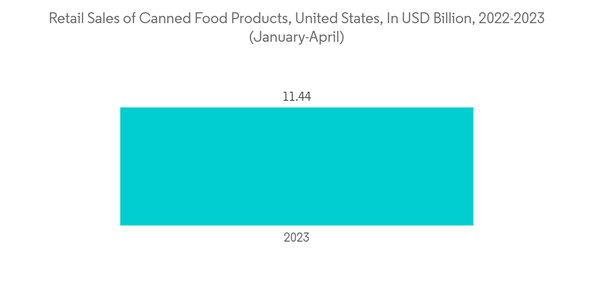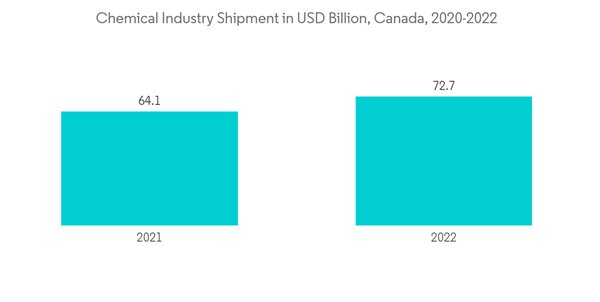Metal packaging is gaining popularity in the North American region with the increasing consumption of canned food products to reduce the problem of food wastage and food loss along with the changing lifestyle of consumers. In addition to this, the adoption of metal cans for a variety of drinks,riety of drinks, such as energy drinks, alcoholic drinks, and others, drives the sales of metal packaging products in the region. In April 2023, Kirin-owned New Belgium Brewing announced the launch of a hard juice seltzer-style beverage in the United States. The hard juice will be launched in metal cans.
Key Highlights
- The trend for lightweight and recyclable packaging solutions among brand owners and consumers makes metal packaging products the ideal choice of packaging formats. Metal packaging products such as cans are convenient and on-the-go, especially for the food and beverage industry. Also, the trend for single-serve aids to the demand for metal cans for food and beverage products.
- The recyclability property of metal packaging products will help the brands achieve the recycling rate targets set by the Can Manufacturers Institute (CMI). The CMI had set a recycling rate of 45 percent in 2020 to a 70 percent recycling rate for aluminum beverage cans by the end of 2030 to 90 percent in 2050.
- The use of metal packaging is also increasing in other end-use industries, such as cosmetics, chemicals, paints, and others. The positive outlook of these industries in the North American region is expected to have a significant impact on the metal packaging market during the forecast period. The trend for decorative paint sprays in the automotive industry will push the sales of aerosol cans.
- Besides this, the availability of other packaging materials constituting similar properties with the advent of advanced technology is projected to create a market challenge for metal packaging manufacturers in the region.
North America Metal Packaging Market Trends
Metal Food Cans Addressing the Food Loss and Wastage Issue Drive the Market
- The concern regarding food loss and wastage is increasing among the food brands as well as the consumers. According to the study, around 40% of food in emerging economies is wasted during the first two steps of the value chain, whereas in mature economies, around 40% of the food wastage is during the last two steps of the value chain.
- The packaging of the product and processing can impact both economies as it lies in the middle of the value chain. Metal food cans serve as an ideal and unique packaging format when compared to other packaging types as the metal cans are hermetically sealed, which helps preserve the food content and the nutrients for very long periods of time.
- In addition, the process of canning also helps destroy a variety of deactivated enzymes and pathogens that otherwise may lead to premature deterioration of food. The heat treatment for canning ensures the destruction of spores of B.cereus, which otherwise leads to intestinal illness. The canned food products do not require refrigeration until served, leading to significant energy savings. Thus, the mentioned factors offer safe transportation of food products throughout the value chain and maintain nutritional value and product quality for a longer period.
- According to the United Nations Environment Programme (UNEP), around 133 billion pounds of edible food in the United States goes to waste every year. The food waste costs about two percent of the country's GDP. Also, food waste contributes 21 percent volume of material in U.S. landfills. The government initiative and programs to reduce food waste and food loss are expected to create market opportunities for metal packaging manufacturers in the region.
- The food brands are trying to address the food wastage concern by adapting metal cans for the food products. The retail sales of canned food products in the United States have increased compared to the previous year, accounting for USD 11.44 billion in 2023 (January-April) from USD 10.49 billion in 2022 (January-April).
- The metal food cans also address the single-serve concern, resulting in portion control. Portion control cuts down food wastage as it encourages the individual to consume the desired amount of portion.
Chemical Sector in Canada Aid to the Growth of Metal Packaging
- Bulk containers, shipping barrels, and drums are used for storing and transporting chemical products. Chemical manufacturers must abide by chemical handling and safety precautions while selecting the proper packaging formats. The improper packaging of chemical products leads to the risk of accidents. Also, the chemical packaging needs to be leak and spill-proof for safe handling and disposal, along with meeting stringent regulations.
- The metal containers are the ideal packaging format and material for storing flammable solvents. The flammable solvents are liquids with a flashpoint of approximately 37.8 degrees Celsius. It is the lowest temperature where vapor is released to ignite. There are chances of danger to be caused as vapor is prone to ignition by naked flames. The metal packaging products protect the flammable solvents against naked flames.
- The expanding chemical sector in Canada is expected to push the demand for metal packaging. The chemical industry shipment in Canada for the year 2022 stood at USD 72.7 billion from USD 64.1 billion in 2021. An increase of 13.5 percent was observed in 2022 compared to 2021. Also, the shipment of industrial chemicals increased by 11.2% in 2022, accounting for USD 34.2 billion from USD 30.5 billion in 2021.
- Furthermore, metal packaging products are not suitable for certain chemical categories as metal is reactive, which may cause danger. This may create a challenge for metal packaging manufacturers dealing in the chemical sector. The metal packaging manufacturers are trying to overcome the challenge by applying advanced coating and painting to the metal containers.
North America Metal Packaging Industry Overview
The North American metal packaging market is characterized by its fragmented nature, boasting a multitude of players. Prominent companies in this market include Ardagh Metal Packaging S.A. (Ardagh Group), Crown Holdings, Inc., Ball Corporation, Mauser Packaging Solutions, Silgan Holding, Inc., GREAT WESTERN CONTAINERS INC., among others. These industry players are actively vying for market share by introducing innovative products that align with prevailing consumer trends. Additionally, they are pursuing strategies such as acquisitions to strengthen their presence in both local and global markets and enhance their brand portfolios.In April 2023, members of the Can Manufacturers Institute (CMI), which encompasses aluminum beverage can manufacturers and can sheet producers, joined hands with the CMI to endorse the transition strategy of the Mission Possible Partnership (MPP). This collaborative strategy is dedicated to reducing the carbon footprint within the aluminum beverage can industry and augmenting the recovery of used beverage cans. It is also geared towards assisting manufacturers in reaching the targeted recycling rates for aluminum beverage cans in the United States.
In January 2023, Ardagh Metal Packaging S.A. (Ardagh Group) announced the expansion of its product offerings for the beverage sector. The company introduced a new 19.2 oz. (568 ml) beverage can cater to the increasing demand for single-serve consumption. This strategic move addresses the evolving preferences of consumers for smaller beverage sizes.
Additional Benefits:
- The market estimate (ME) sheet in Excel format
- 3 months of analyst support
This product will be delivered within 2 business days.
Table of Contents
Methodology

LOADING...










